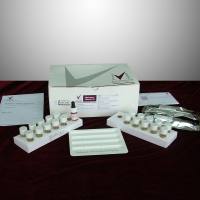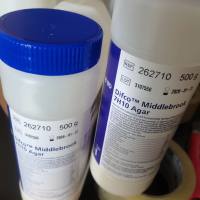Partial proteolysis with Staph. aureus V8 protease
互联网
Materials:
Overlay/Rehydration buffer:
125 mM Tris-HCl, pH 6.8
1mM EDTA
0.1% SDS
1mM 2-b-mercaptoethanol
30% glycerol
some Bromophenol blue
For 1 ml, you will need
0.35 ml of 2X buffer
0.30 ml H20
0.30 ml glycerol
0.05 ml BPB
Enzyme buffer:
125 mM Tris-HCl, pH 6.8
1mM EDTA 0.1% SDS
1mM 2-mercaptoethanol
10% glycerol
some phenol red
For 1 ml, you will need
0.45 ml of 2X buffer
0.30 ml H2O
0.10 ml glycerol
0.15 ml phenol red
The best way to make all of these is to have a stock that does not contain mercaptoethanol and to make up what you need for one day each time you do this. Then, when you are done, throw away the excess containing the mercaptoethanol. Otherwise there is no way to know whether there is too much, or too little mercaptoethanol in the solutions.
Both extremes are a problem. If you have too little ME, the protein won't come out of the gel. If you have too much, the V8 won't work. The molarity of neat mercaptoethanol is approximately 14. 1 microliter of ME per 14 ml of solution gives a 1 mmolar solution.
Enzyme stock solution:
![]() 500 micrograms/ml (or 500 nanograms/microliter) V8-protease in 125 mM Tris-HCl, pH 6.8, and 1mM EDTA. This is in Tilo's box 3, in the east Forma, #1.
500 micrograms/ml (or 500 nanograms/microliter) V8-protease in 125 mM Tris-HCl, pH 6.8, and 1mM EDTA. This is in Tilo's box 3, in the east Forma, #1.
Generally, if you aren't sure how much enzyme to use, try 10, 50 and 100 nanograms of V8 protease. If V8 doesn't work for your protein, try papain or chymotrypsin. Jan Buss once had to use 1 microgram of V8 to get good digestion. There are no rules and every protein is different. We always try V8 first.
You need a set of working solutions that will give you the desired weight of protease in 10 microliters. for example:
for 10 ng, use 1 microliter stock V8 in 500 microliters enzyme buffer.
for 25 ng, use 1 microliter stock V8 in 200 microliters enzyme buffer.
for 50 ng, use5 microliters stock V8 in 500 microliters enzyme buffer.
Those familiar with differential equations or analytic geometry can calculate other amounts.
 Procedure:
Procedure:
In general short gels give the best looking patterns. Remember that the bottom of the stacking gel should be 30 mm from the upper end of the notched plate, not 23 mm.
Excise the gel piece. The prep gel should be unfixed, unPPO'ed and have been dried after running. It is OK to soak the gel in H20 prior to drying.
Scrape off backing paper and trim the pieces to 3 mm (which is the size of the 28-tooth comb wells).
Rehydrate the gel pieces in 100 microliters of rehydration/overlay buffer for 1-2 min. Do not over-hydrate. The pieces will become too fragile and will fragment.
Place the gel pieces in the wells of the gel, using the teflon tamper to push them down to the bottom. Add 10 microliters of the Rehydration/Overlay buffer. This will seal any space between the gel pieces and the wells.
Add the desired amounts of protease (10, 50, 200 ng, or whatever works for your protein) in 10 microliters of enzyme buffer.
The protease inevitably leaks from one well to another. Therefore, it is best to group the samples such that all that are to be digested with 10 ng of protease are next to each other, all that are to be digested with 50 ng are next to each other, and separated from those getting digested with 10, and so forth.
Start electrophoresis as usual.
When the dye front is 3 to 4 mm above the top of the resolving gel, turn off the power for exactly 30 min. Then turn it on again.
When the dye is completely in the separation gel, turn up the current to whatever you would normally use for the kind of gel you are running and proceed as usual.










